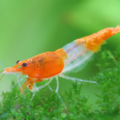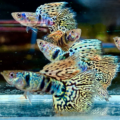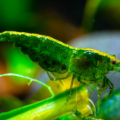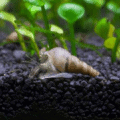Dive into the world of Red Cherry Shrimp! This care guide provides essential tips for creating a colorful, lively aquarium that your shrimp will love.

If red Jolly Ranchers are your ultimate favorite, then the Red Cherry Shrimp (Neorcaridina davidi) is your tank’s sweet treat! These vibrant shrimp for aquariums will add the right pop of color and a dash of excitement. Whether you are a beginner or a veteran hobbyist, these adaptable unique shrimp will add more personality variability to your tank.
Known for their dazzling bright red hues, these sturdy little wonders bring exuberance and fun to any tank setup. The Red Cherry Shrimp characteristics are resilient, adaptable, and perfect for beginners and advanced aquarists. With minimal transparency in their deep red shells, these shrimp are true showstoppers among popular shrimp types.
- Adult size: 1.2-1.6 inches
- Color Pattern: They have different grades ranging from Cherry grade (lowest) to Bloody Mary (highest). See chart below. Their colors can be bright red with minimal transparency
- Unique Traits: They are sociable, eat lots of algae without harming your plants and breed easily

Creating the Perfect Tank for Red Cherry Shrimp: Essential Setup Tips
Red Cherry Shrimp may be hardy, but they still appreciate a cozy setup! Start with at least a 5-gallon or 10-gallon (if you have plans to cultivate a healthy breeding colony), and keep those shrimp tank essentials in check by following these conditions for freshwater shrimp care:
- Water Temperature: 72-78 degrees Fahrenheit
- Water pH: 7.0-7.8
- Water Hardness: GH of 9-12. Hard level for shell health
- Aquarium Lighting: Standard tank lighting
Should you add plants to the tank? Absolutely! Red Cherry Shrimp thrive with a natural touch. Think fine dark substrate for burrowing and accentuating their shell color; plenty of flamboyant plants for hiding. The Red Cherry Shrimp habitat loves lush greenery, which doubles as a snack bar and playground!
Feeding Red Cherry Shrimp: Nutrition Tips for Enhanced Color
If you are looking for that “wow” factor in shrimp color, no gatekeep, diet is the solution! These freshwater shrimp love a balanced menu which includes algae wafers, shrimp pellets, blanched vegetables, eating algae and biofilm on tank plants. Color-enhancing shrimp food doesn’t just keep them happy; it intensifies those ruby tones!
For more on feeding your aquatic pets check out The Ultimate Guide to Fish Food: Pros and Cons & Best Choices!
Feeding them once or twice daily is recommended. Just remember, no overfeeding! You want vibrant shrimp, not overstuffed ones. Red Cherry Shrimp diet tip: a varied diet equals brighter color!

Since these freshwater shrimp are great scavengers, they will look to keep the tank clean of uneaten food and debris. Establishing feeding habits for aquarium shrimp is needed if there is a lot of debris for them to feed off in the tank.
Because of their small size, they will not consume past what they can handle, leaving the possibility of leftover food which can negatively affect your tank water. Ensure any uneaten leftover food is removed from your tank within 24 hours.
Breeding Red Cherry Shrimp: Step-by-Step Guide
Who here likes a good ‘ole shrimp family reunion? Breeding Red Cherry Shrimp is simple as long as they are in a stress-free environment and their water conditions are stable and it is fresh water. The females carry the eggs under their belly which means she is “berried”. Once they hatch, the juveniles are self-sufficient.
This video has been very helpful in identifying the sex of Neocaridina Shrimp, I highly recommend it:
Caring for shrimp eggs is simple, just make sure to place a fine sponge pre-filter on the power filter intakes —ensuring the baby shrimp do not get sucked into the filter when the eggs hatch.
Additionally, They will easily be welcomed into the crew without any fuss as shrimp are peaceful, making this process easy and rewarding. Keep in mind that mixing neocaridina shrimp varieties carries the risk of interbreeding different color varieties from the different variants which will result in their offspring not inheriting their parent’s coloration.
It is not a terrible thing, but if you hope to pass on the chocolate shrimp’s brown coloration, it is best to do so in a chocolate shrimp only tank. The mixed offspring would instead inherit a wild coloration.

Last, if you have a community tank of varied species housed with your Red Cherry Shrimp that their offspring (shrimplets) will be at risk of being eaten. The next section goes into more detail on choosing your shrimps tankmates.
Choosing Tank Mates for Red Cherry Shrimp: Building a Peaceful Community
Red Cherry Shrimp are so social, the new phrase should be “social cherry shrimp” instead of social butterflies. They appreciate a calm, unproblematic neighborhood. The best tank mates for shrimp will keep everyone safe and happy!
Avoid the big bullies—larger fish may see your shrimp as an all-you-can-eat opportunity! Always choose the peaceful aquarium community if you want your shrimp and ecosystem to be stress-free and thriving.
Compatible Species: small Tetras, Rasboras, Amano Shrimp, Bamboo Shrimp, and even Vampire Shrimp
Incompatible Species: Cichlids, angelfish, goldfish, pea puffer fish etc.

Preventing Health Issues in Red Cherry Shrimp: Essential Care Tips
Despite these vibrant shrimps having hardy personalities, they still are vulnerable and sensitive. Motling issues and sensitivity to copper are extremely common especially because they are part of the Neocaridina shrimp family.
Make sure you are vigilant when it comes to the water quality stats. Regular tank maintenance is a non-negotiable because it will be preventing shrimp illness; making a big difference between life and potential death for your crustaceans.
Ensure any products you buy for your tank involving them have no copper-based treatments. For example, certain plant fertilizers contain trace amounts of copper.
Other elements harmful to these freshwater fish that are common in the aquarium are Ammonia, Nitrite, and Nitrate. Ways to decrease the levels of these elements is by ensuring leftover foods are removed and a well-maintained filtration system; which will eliminate contamination.
Some signs of shrimp health problems to look out for are lethargy or faded color—your shrimp’s way of calling for an SOS. You know your shrimp has passed if it is lifeless and has turned a pale pink color.
Typical Red Cherry Shrimp molt every three to four weeks. However, juvenile shrimp molt on average once a week since they are at the stage of rapid growth rate.

These freshwater shrimp molts by relaxing their muscles and squeezing out of their exoskeleton, leaving an intriguing translucent “molt” behind. It is often mistaken for a dead shrimp, so do not panic!
Another plus, since their molt contains lots of nutrients, they are readily eaten by others from your colony as the freshly molted shrimp goes into hiding. So, make sure you have lots of plants to make their process stress-free!

Following these Red Cherry Shrimp health care basics will keep them in top shape.
Maximizing the Lifespan of Red Cherry Shrimp
With the right care and ideal conditions, these tiny wonders of the aquarium can live up to 1-2 years. Diet, water quality, and low stress should be your main focus to extending shrimp lifespan.
Long-lasting shrimp care such as routine maintenance, balanced feeding (as mentioned previously), and keeping the tank conditions stable will ensure the lifespan of Red Cherry Shrimp is long-lasting. So much so, enough to be tank mates to new critters you adopt.
Conclusion
In summary, Red Cherry Shrimp are the perfect blend of vibrant elegant beauty and hardy resilience, making them a top choice in any aquarium. They have beginner-friendly shrimp care, meaning they can adapt to many setups, but just make sure those setups have a baseline of high-quality cleanliness.
Whether you are new to learning about shrimp or an expert aquarist, this Red Cherry Shrimp guide will help you with maintaining aquarium shrimp, keeping your aquarium colorful and full of life.











1 thought on “Red Cherry Shrimp Care Guide: Bringing Color and Life to Your Aquarium”